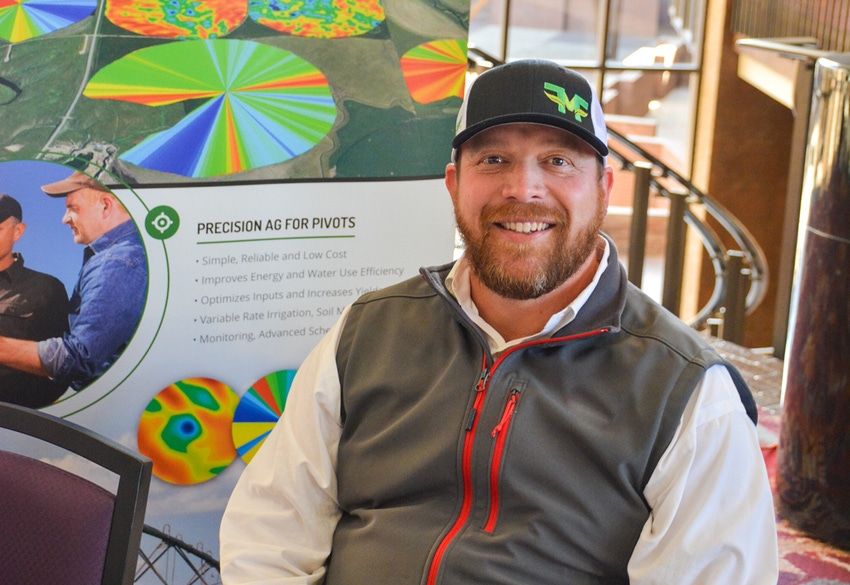
When. Where. And how much. These are all factors considered and answered in an irrigation variable rate prescription. And for many growers in the Southwest, where irrigation water is limited, variable rate technology is one tool being used to increase irrigation efficiency, along with profitability.
"What we were trying to do is compare a grower's standard — what guys have normally done to schedule their irrigation — versus variably applying water," says Jeff Miller, agronomist and CEO of Forefront Agronomy. "Not every one of these fields is table-top flat; there's some variation across the field. We also have a prevailing southwest wind, so if there's a way we can apply our water differently and still get the biggest bang for our buck, that's our premise."
Miller, along with Parmer County grower Kelly Kettner, were opening speakers at the Texas Alliance for Water Conservation (TAWC) Water College at Lubbock. Kettner and Miller partner with TAWC on a producer project. While Kettner discussed the role of carbon, cover cropping, and residue in conserving water, Miller focused on the use of variable rate irrigation on Kettner’s farm.
DEVISED PRESCRIPTION
When Miller and Kettner began working together, Miller drew up a prescription based on Kettner’s soil parameters and the crops he was growing. He then split Kettner’s pivot into zones where the sprinkler could be sped up or slowed down to adjust the application rate, along with adjusting watering amounts for different crops — corn on the south half and cotton on the north half of his circle. Rates were also adjusted to not overwater Kettner’s lake bottom.
“We changed the prescription five or six times throughout the season, mostly on what we needed the cotton to be,” Miller says. “As we got further into the season, we added more to the cotton and less to the corn.” The corn was planted at a lower population and made 19 tons of corn silage. “What I noticed down his hillside was that the corn stayed very consistent. Plant height and ears were the same across all zones.
See, Texas growers convert pivot acres to drip
“As we got into the cotton, we hardly put any water on the cotton early. Once we got into bloom, we started increasing irrigation amounts to finish out the crop. Overall, he made 1,550 pounds on a pivot nozzled at 300 gallons,” says Miller.
When it comes to irrigation, it’s not one size fits all. “Often people think because they have a spot that is non-producing, they need more inputs, or if an area is high producing, they need to apply less. In a lot of cases, it’s more about taking the information we have available: soil types, elevation, and electro-conductivity maps (determines soil texture), then using the information to determine what needs to be done. It’s not going to be the same from one field to the next. It’s very field-specific.”
PRODUCER GOALS IMPORTANT
Miller says, when developing a prescription, the goals of the producer are important as well. “But it’s got to start with a base soil type and then we can adjust the other variables in applying irrigation when it needs it; where it needs it; and how much it needs.”
Over the last two years, through Miller's partnership with TAWC's producer projects, growers using variable rate technology to grow cotton have seen a 150-pound yield increase applying a half-inch less water and a $72 per acre return on their investment over a two-year period.
“Whenever we talk about applying water variably, in your mind you might think it’s a big amount of water — an inch difference. In most cases, the prescriptions we’ve written are less than a quarter of an inch difference, and still give us this 150-pound yield advantage,” says Miller.
“It’s small increments that add up over time, giving the plant exactly what it needs at the right time, versus spinning the pivot around like we always have.”
COUNTING THE COST
As with most technology, variable rate is an investment with a tiered approach, says Miller. First, a grower needs to have soils tested, which is about $8 to $10 per acre. Once that information has been received, a prescription can be built, which is about $3 to $5 per acre annually.
See, Eddie Teeter honored for service, commitment
Growers also will need to invest in a pivot controller to deliver the prescription, with an initial investment of about $2,000 and a yearly renewal fee of about $300. Miller also advises purchasing soil moisture probes. “The probes can tell you exactly what the plant is doing, where your roots are, and help you understand how to adjust the variable rate.”
But before converting every pivot to variable rate technology, Miller recommends starting with one farm with the greatest amount of variation. “It’s an adoption process,” he says. “With any new technology, there’s a learning curve. I recommend focusing on one field for a year, learning from it, and then moving forward to use that knowledge on the other fields.”
While grower profitability is important, Miller says, if a grower can save water each year and extend the life of the aquifer, it’s a win-win. "Whenever we start thinking about sustainability, we've got to make money to stay here. But we've also got to be here as long as we possibly can. Looking at technology like this is allowing us to strive for these goals."
See, Photo Gallery, TAWC hosts 5th annual Water College
About the Author(s)
You May Also Like






